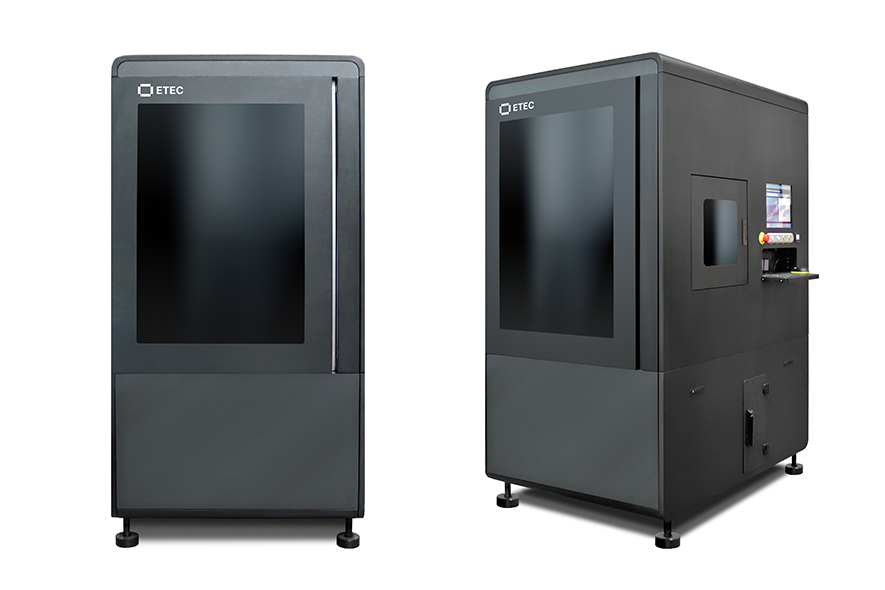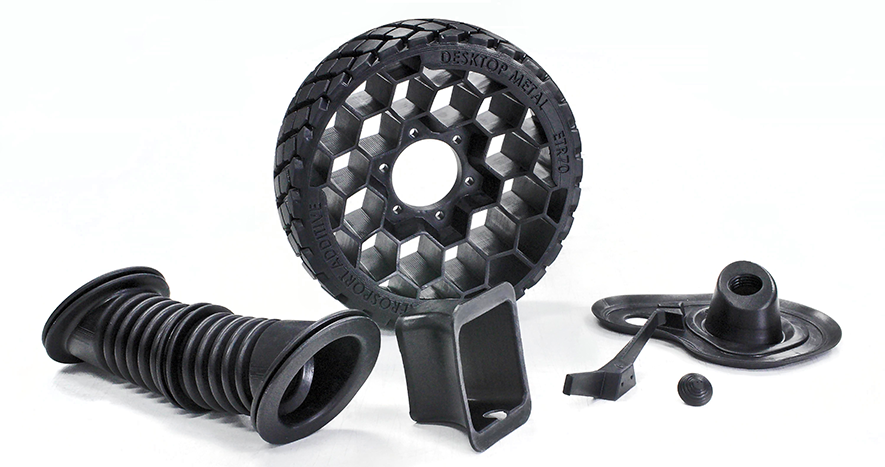
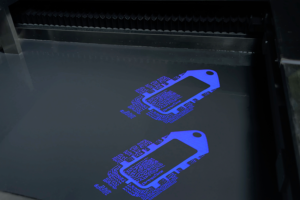 Within the complex field of 3D printing technologies, Digital Light Processing (DLP) is easily one of the most simple, mature, and popular methods available for polymer parts manufacturing. DLP, harnesses the power of light from a projector to cure photosensitive liquid resins into parts layer by layer, one quick flash at a time. A 3D printing process that’s been used since 1999, DLP was invented as a significant speed advancement over stereolithography, or SLA, which cures photosensitive resin with UV light from a laser beam, drawing parts out individually one layer at a time. More than 20 years later, DLP is one of the more mature processes in the field of 3D printing.
Within the complex field of 3D printing technologies, Digital Light Processing (DLP) is easily one of the most simple, mature, and popular methods available for polymer parts manufacturing. DLP, harnesses the power of light from a projector to cure photosensitive liquid resins into parts layer by layer, one quick flash at a time. A 3D printing process that’s been used since 1999, DLP was invented as a significant speed advancement over stereolithography, or SLA, which cures photosensitive resin with UV light from a laser beam, drawing parts out individually one layer at a time. More than 20 years later, DLP is one of the more mature processes in the field of 3D printing.
Today, this highly affordable, accurate and highspeed printing technology is used for everything from prototyping to volume production of end-use parts, including those with demanding precision, surface finish, and functional requirements.
History of DLP
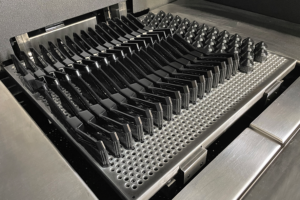 Over its 20-plus years of existence the DLP process has largely been executed in the same way: a video projector is stationed below a vat of photosensitive resin, and print jobs are built as a job advances vertically out of the vat attached to a build plate. While the field has enjoyed many advancements, most have been incremental in nature and focused on limiting the detrimental separation forces inherent to building parts bottom-up.
Over its 20-plus years of existence the DLP process has largely been executed in the same way: a video projector is stationed below a vat of photosensitive resin, and print jobs are built as a job advances vertically out of the vat attached to a build plate. While the field has enjoyed many advancements, most have been incremental in nature and focused on limiting the detrimental separation forces inherent to building parts bottom-up.
As global manufacturers begin to utilize 3D printing for the production of functional end parts, there is a requirement to print larger batch sizes, bigger parts and engineered polymers. These requirements shine the spotlight on the limitations of bottom-up DLP.
For one, there’s a limit to how many parts and how much weight can be suspended vertically from a build plate when printing with a bottom-up projector. More importantly, this printing approach forces serious constraints on the types of resins that can be used. Because the resin in the bottom-up DLP printing approach must flow back under the build plate easily and quickly during recoating, it must be a relatively low viscosity. This ultimately limits the final material properties the resin can deliver, or requires two-part resins that must be mixed together then quickly printed before they spoil.
Top-Down Developments
The SLA market, the precursor process to DLP, has long offered a healthy commercial market for both bottom-up and top-down designs, with bottom-up styles often featured in more affordable desktop units while industrial models often deploy the top-down approach.
Now, ETEC is embarking on this more industrial approach to DLP with the Xtreme 8K. This cutting-edge DLP machine features a top-down design with two industrial overhead projectors stationed above the resin vat. This allows the Xtreme 8K to offer the largest DLP build area — 166,950 mm2 (450 x 371 mm) — among commercially-available, production-grade DLP printers. Additionally, two intense and direct light sources that don’t have to penetrate through a vat film or tray enable new materials with higher energy requirements for curing.
This innovative machine design has unlocked the ability to produce large parts and manufacture in high-volumes with DLP 3D printing as well as process new materials that directly compete with thermosets used in traditional plastic injection molding.
Breakthrough New Category of Photopolymers
Many of the initial low-viscosity photopolymer resins used in vat photopolymerization – whether DLP or SLA – were derived from the protective coatings industry, where they were applied in ultra-thin layers and then cured with UV lights.
During curing, the materials are crosslinked, or chemically bonded to form a polymer. While these early photopolymer resins rapidly cure and offer good surface finish, they tend to be brittle and prone to cracking and shattering, offering poor impact resistance and little of the toughness and resilience needed to compete with today’s traditionally manufactured plastics. Their performance also tends to degrade over time or as parts are exposed to light and hot or cold temperatures.
For decades, the field of polymer AM has been working to enhance the material properties to overcome these hurdles and deliver more resilient, elastomeric properties.
DuraChain is a new category of materials invented by Adaptive3D, a subsidiary of Desktop Metal, to solve these problems. Adaptive3D developed a proprietary and unique blend of materials that takes advantage of a specific chemical reaction process, called Photo Polymerization-Induced Phase Separation, or Photo PIPS, to deliver all-new material properties in DLP.
When exposed to light during DLP printing, DuraChain photopolymer resins phase separate at the nano level and then cure into a resilient, high-performance network much like legacy two-part material systems that have a shorter pot life. One of the challenges in printing these materials is that they contain high-viscosity base oligomers — similar to honey or molasses — and miscible monomers that would not be easy to process on bottom-up DLP systems, which require more free-flowing resins.
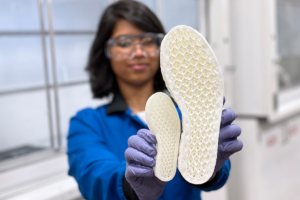 Ultimately, this groundbreaking portfolio of photo-elastomers is delivering the tough and resilient properties that the market requires — with high tear strength, elongation, and toughness. What’s more, this unique approach is delivered in a one-part, pot-stable chemistry. Because these materials are so viscous and produce durable parts they currently require a top-down DLP printer for processing.
Ultimately, this groundbreaking portfolio of photo-elastomers is delivering the tough and resilient properties that the market requires — with high tear strength, elongation, and toughness. What’s more, this unique approach is delivered in a one-part, pot-stable chemistry. Because these materials are so viscous and produce durable parts they currently require a top-down DLP printer for processing.
Read more about the technological advances in Digital Light Processing; Download the New-for-2022 26-page Ultimate Guide to DLP.
Subscribe to Our Email Newsletter
Stay up-to-date on all the latest news from the 3D printing industry and receive information and offers from third party vendors.
You May Also Like
3D Printing Financials: Fathom Struggles in Financial Quicksand During Critical Transition
Facing a year of key transitions and financial pressures, Fathom (Nasdaq: FTHM) has filed its annual report for 2023 with the U.S. Securities and Exchange Commission (SEC). The document outlines...
Latest Earnings Overview for Australian 3D Printing Firms Titomic and AML3D
Australian 3D printing manufacturing firms Titomic (ASX: TTT) and AML3D (ASX: AL3) reported their financial results for the period from July to December 2023, marking the first half of their...
3D Printing Webinar and Event Roundup: April 7, 2024
Webinars and events in the 3D printing industry are picking back up this week! Sea-Air-Space is coming to Maryland, and SAE International is sponsoring a 3D Systems webinar about 3D...
3D Printing Financials: Unpacking Farsoon and BLT’s 2023 Performance
In the Chinese 3D printing industry, two companies, Farsoon (SHA: 688433) and Bright Laser Technologies, or BLT (SHA: 688333), have recently unveiled their full-year earnings for 2023. Farsoon reported increases...


